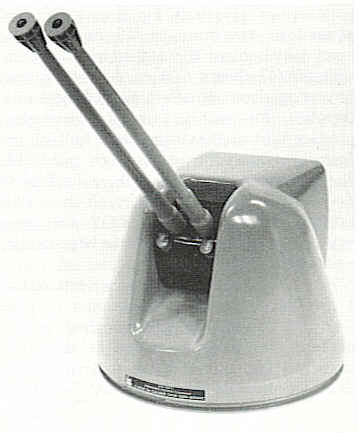This page is a collection of experimental and proposed USA 5.4" (13.7 cm) and 5" (12.7 cm) guns of the 1940s to 1960s period. As detailed information for these guns is limited, I have decided to combine them into a single page, rather than creating a page for each one.
This weapon was part of a 1939 - 1940 study on possible replacements for the 5"/38 (12.7 cm) Mark 12. During this study, a variety of guns were investigated for arming a new generation of destroyers, cruisers and battleships. Requirements for the new weapon included the ability to achieve a slant range of 14,000 yards (12,800 m) and a maximum surface range of at least 18,000 yards (16,500 m). Projectile weight was to be no more than 75 lbs. (34 kg), muzzle velocity not less than 2,700 fps (823 mps) and a rate of fire of not less than 15 rounds per minute at any elevation. Besides the 5.4"/48 (13.7 cm), an up-rated 5"/38 (12.7 cm), a new 5"/54 (12.7 cm) and an improved 6"/47 (15.2 cm) were also considered.
Although the existing 5"/38 (12.7 cm) did not meet any of the above requirements, it did have a significantly lower mounting weight than any of the larger guns. This meant that more of them could be accommodated on the same size ship. For example, BuOrd calculated that a ship capable of carrying eight 5"/38 (12.7 cm) guns could only carry six 5"/54 (12.7 cm) guns and even fewer of the larger calibers. When the increased weight was taken into account, BuOrd could see no advantage to larger calibers and recommended that the planned new ships continue to use the existing 5"/38 (12.7 cm). BuOrd did recommend in January 1940 that development of the 5"/54 (12.7 cm) be pursued as its heavier shell would mean an improved anti-surface capability over the 5"/38 (12.7 cm). This resulted in the 5"/54 (12.7 cm) Mark 16 which was chosen to arm the Montana class (BB-67) battleships and the Midway class (CVB-41) carriers.
As for the 5.4"/48 (13.7 cm), it was temporarily revived as a possible armament for the proposed 8,000 ton cruisers when the new 6"/47 (15.2 cm) failed its preliminary tests, but this fell through when BuOrd reported that it would take at least 30 months just to get the design to the proofing stage. The 5"/54 (12.7 cm) could be produced three to four months quicker, as it could use some of the existing tooling used for the 5"/38 (12.7 cm).
Experimental AAA weapon of the late 1940s - early 1950s that did not enter service use. This was a loose liner gun designed to fit into the 6"/47 (15.2 cm) turrets used on the Worcester class light cruisers. Development may have been a joint effort with the British 5"/70 (12.7 cm) QF Mark N1, similar to the program for the 3"/70 (7.62 cm) guns of the same era. Gun weight was 9,340 lbs. (4,237 kg) not including breech. Fired the same 70 lbs. (31.8 kg) projectiles as the 5"/54 (12.7 cm) guns, but had a muzzle velocity of 3,400 fps (1,036 mps) with a 36 lbs. (16.3 kg) propellant charge. Pressure was 21.5 tons/in2 (3,386 kg/cm2). Mods 0 and 2 had uniform RH 1 in 25 rifling while Mod 1 had increasing RH 1 in 50 to 1 in 25 rifling.
A proposed alternative to the 5"/54 (12.7 cm) Mark 45, this 1960s design was a faster firing weapon, with a ROF of 48 rounds per minute. Ammunition supply was complex, with eight ammunition drums holding 12 rounds each feeding a central carrier ring which held an additional 16 rounds. The drums needed to be manually loaded, but a single crewman could fire all of the ready rounds without assistance. No prototypes were built and the project was cancelled at the end of the 1960s.
Essentially a twin version of the Mark 65, with each gun fed by a single 100 round drum. As in the Mark 65, a single crewman could fire all ready rounds without assistance. This mount was intended for the proposed fire support ships of the 1960s. No prototypes were built and the project was cancelled at the end of the 1960s.

Data from:
- "US Naval Weapons" by Norman Friedman
